出血性脑梗死
- 格式:ppt
- 大小:1.16 MB
- 文档页数:25
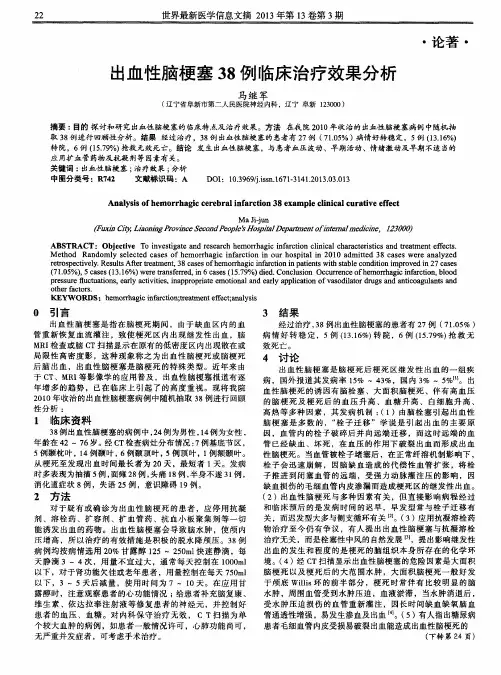
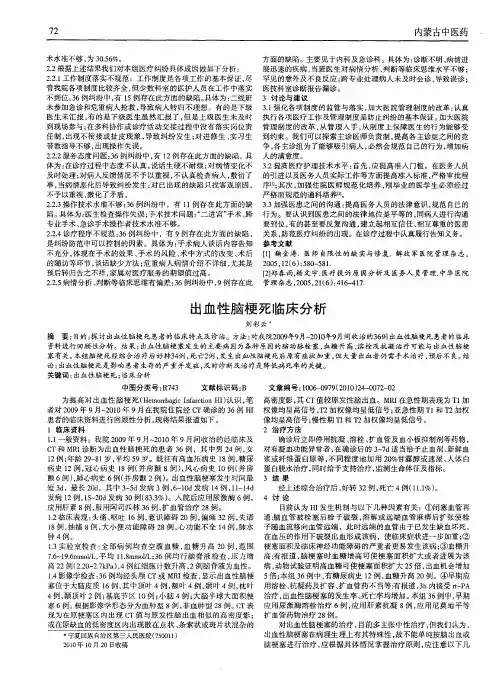
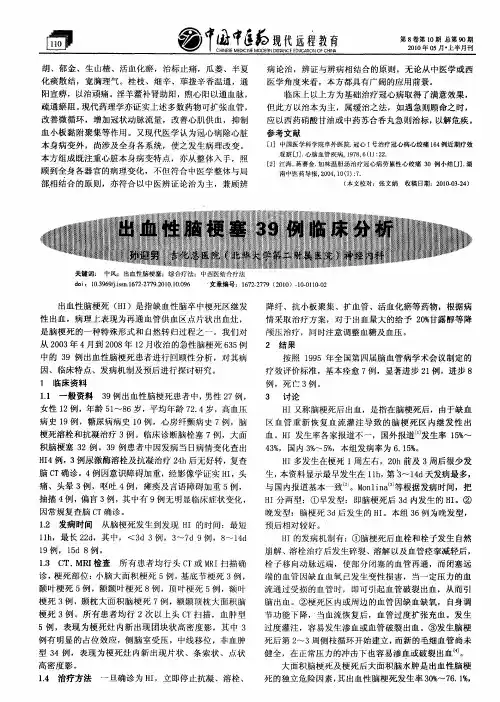
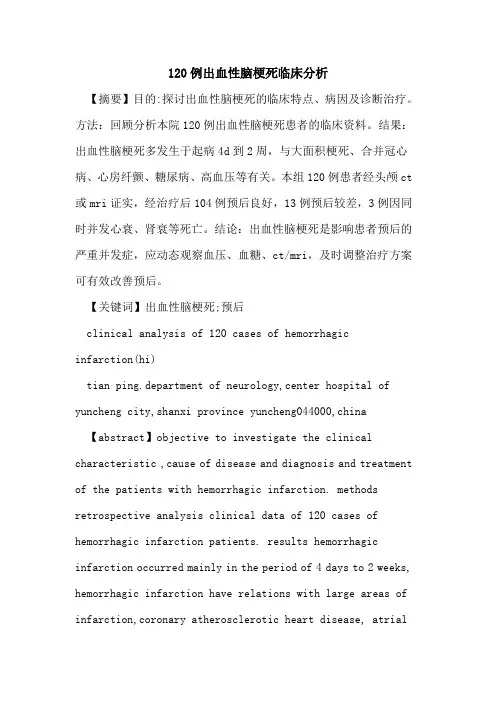
120例出血性脑梗死临床分析【摘要】目的:探讨出血性脑梗死的临床特点、病因及诊断治疗。
方法:回顾分析本院120例出血性脑梗死患者的临床资料。
结果:出血性脑梗死多发生于起病4d到2周,与大面积梗死、合并冠心病、心房纤颤、糖尿病、高血压等有关。
本组120例患者经头颅ct 或mri证实,经治疗后104例预后良好,13例预后较差,3例因同时并发心衰、肾衰等死亡。
结论:出血性脑梗死是影响患者预后的严重并发症,应动态观察血压、血糖、ct/mri,及时调整治疗方案可有效改善预后。
【关键词】出血性脑梗死;预后clinical analysis of 120 cases of hemorrhagicinfarction(hi)tian ping.department of neurology,center hospital of yuncheng city,shanxi province yuncheng044000,china 【abstract】objective to investigate the clinical characteristic ,cause of disease and diagnosis and treatment of the patients with hemorrhagic infarction. methods retrospective analysis clinical data of 120 cases of hemorrhagic infarction patients. results hemorrhagic infarction occurred mainly in the period of 4 days to 2 weeks, hemorrhagic infarction have relations with large areas of infarction,coronary atherosclerotic heart disease, atrialfibrillation, diabetes mellitus, high blood pressure and soon on.120 cases of hi were confirmed by using head ct or mri and after treatment,the prognosis is favorable in 104 cases. 13 cases is not good and 3 cases died from complications as heart failure ,renal failure,etc.conclusion hemorrhagic infarction is the serious complication which affects patients’prognosis,and they needs the dynamic observation with blood pressure, blood sugar andct/mri. adjusting the treatment program can improve its prognosis.【key words】hemorrhagic infarction;prognosis出血性脑梗死(hemorrhagic infarction hi)是指在脑梗死期间,由于缺血区血管重新恢复血流灌注,导致的梗死区内出现继发性出血[1]。
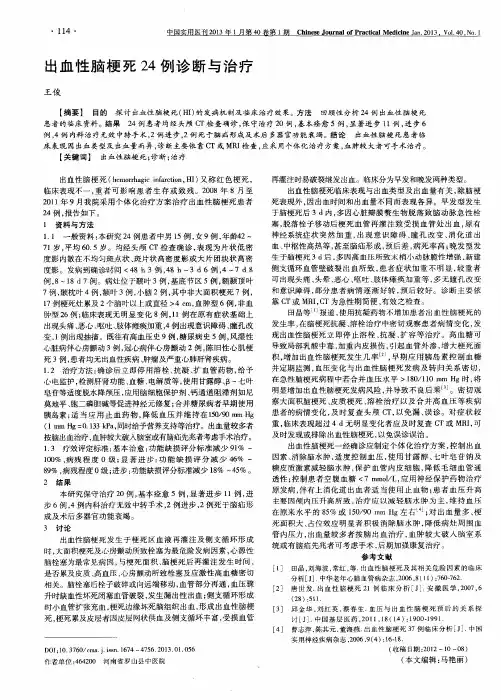
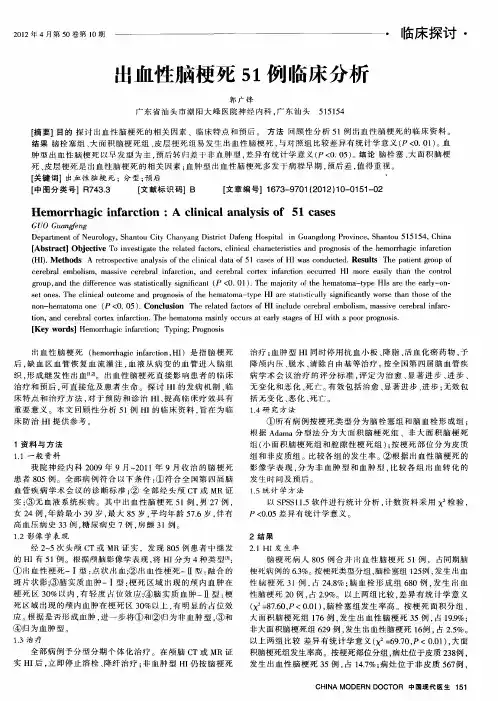
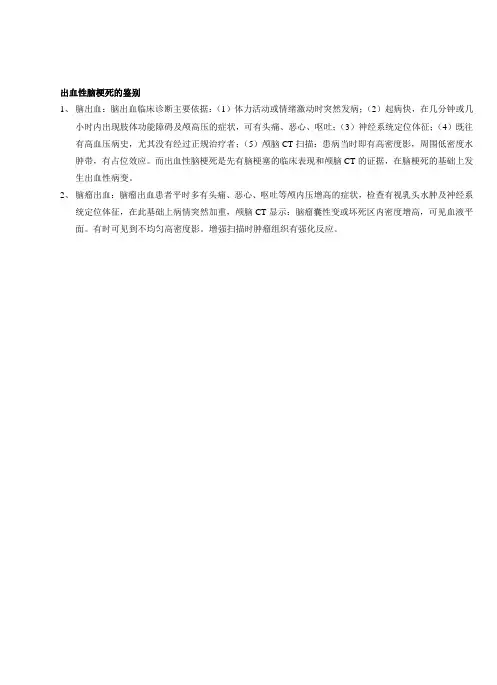
出血性脑梗死的鉴别
1、脑出血:脑出血临床诊断主要依据:(1)体力活动或情绪激动时突然发病;(2)起病快,在几分钟或几
小时内出现肢体功能障碍及颅高压的症状,可有头痛、恶心、呕吐;(3)神经系统定位体征;(4)既往有高血压病史,尤其没有经过正规治疗者;(5)颅脑CT扫描:患病当时即有高密度影,周围低密度水肿带,有占位效应。
而出血性脑梗死是先有脑梗塞的临床表现和颅脑CT的证据,在脑梗死的基础上发生出血性病变。
2、脑瘤出血:脑瘤出血患者平时多有头痛、恶心、呕吐等颅内压增高的症状,检查有视乳头水肿及神经系
统定位体征,在此基础上病情突然加重,颅脑CT显示:脑瘤囊性变或坏死区内密度增高,可见血液平面。
有时可见到不均匀高密度影。
增强扫描时肿瘤组织有强化反应。
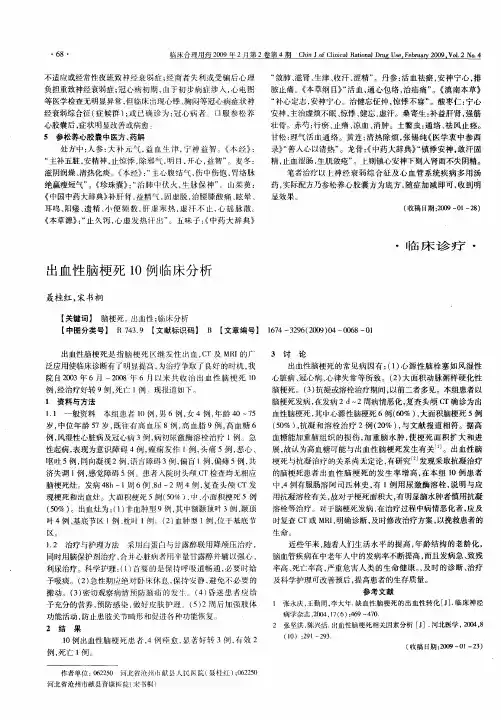

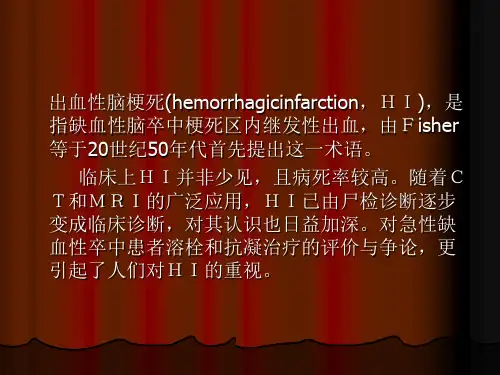
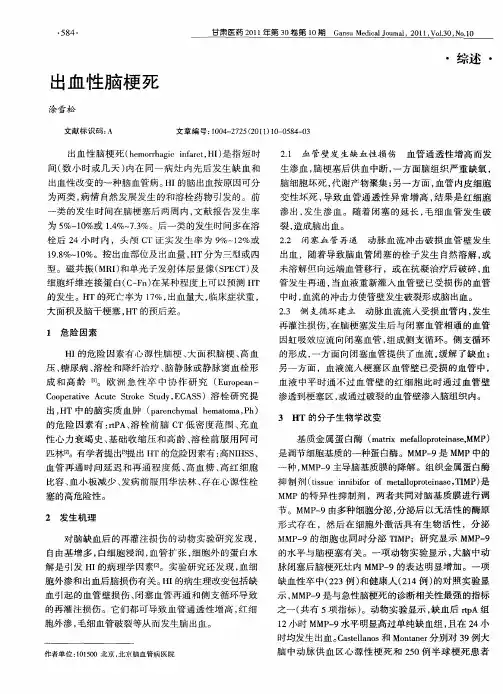
出血性脑梗死的治疗方法
出血性脑梗死是一种严重的脑血管疾病,需要采取及时有效的治疗方法以减少
患者的损害。
在治疗出血性脑梗死时,需要综合考虑患者的病情严重程度和个体差异,制订个性化的治疗方案。
以下是常见的治疗方法:
药物治疗
1. 利尿剂
利尿剂可以帮助降低体内的液体水平,减轻脑组织的水肿程度,有助于缓解症
状和减轻脑部压力。
2. 降压药
出血性脑梗死患者往往伴有高血压,及时降低血压可以减少脑出血的风险,保
护脑部免受进一步损伤。
3. 抗凝血药
在一定情况下,使用抗凝血药可以帮助减少血栓形成,降低二次脑梗死的风险。
4. 营养支持药物
维持正常的营养状态可以帮助患者提升免疫力,加快康复速度。
手术治疗
1. 神经外科手术
对于严重的脑出血病例,可能需要进行神经外科手术,通过清除出血血块、减
轻脑组织压迫,降低颅内压力,挽救患者生命。
2. 血管介入治疗
在特定情况下,可以通过血管介入的方式进行治疗,修复病损的血管,减少二
次脑梗死的风险。
康复治疗
1. 物理治疗
通过物理治疗帮助患者恢复运动功能,缓解肌肉僵硬和疼痛。
2. 语言康复
针对出血性脑梗死导致的语言障碍,进行语言康复训练,帮助患者恢复言语能力。
3. 心理支持
出血性脑梗死患者容易出现情绪问题,心理支持对于患者的康复至关重要。
出血性脑梗死的治疗方法多种多样,但关键在于早期诊断、及时干预和个体化的治疗方案。
患者在治疗过程中要密切监测病情变化,配合医护人员的治疗计划,提高康复的成功率。
出血性脑梗死临床分析作者:郭耀强来源:《中国实用医药》2013年第15期【摘要】目的探讨出血性脑梗死的发病因素及临床治疗体会。
方法回顾分析本院2010年1月至2012年6月66例出血性脑梗死出血性脑梗死患者的临床资料。
结果出血性脑梗死发生时间越早,症状越重,病死率高;66例患者中,基本痊愈9例,显著进步35例,进步19例,死亡3例。
结论对大面积梗死、合并高血压、房颤、糖尿病的患者宜密切动态观察病情变化,注意梗死后出血可能,及时复查头颅影像以调整治疗方案。
【关键词】出血性脑梗死;相关因素;治疗出血性脑梗死(HI)在临床上是急性脑血管病的一个特殊类型[1]。
是在脑梗死灶中出现可成分散状瘀点,以及大片瘀斑的继发性脑出血,严重者可形成血肿,一般是有梗死区血管再通、血管重建而引起。
患者的临床表现上不仅会有脑梗死的症状,同时还伴有颅内压增高、意识障碍、肢体功能障碍等,CT及MRI的广泛应用使出血性脑梗死的临床诊断率有了显著提高,提高了患者的救治率。
治疗上与一般脑梗死有所区别。
回顾分析我院2010年1月至2012年6月66例出血性脑梗死临床资料,现总结、报告如下。
1 资料与方法1.1 一般资料选择本院2007年5月至2009年5月脑梗死患者279例,以上患者诊断均符合中华医学会第四次全国脑血管疾病学术会议制定的《各类脑血管疾病诊断要点》中的诊断标准,其中女26例,男40例。
患者年龄42~79岁,平均年龄61.5岁。
66例脑梗死病例均经头颅CT或MRI确诊,66例HI患者共行96次,其中首次检查检出HI42例,第2次检查检出18例,第3次检查检出6例;其中小面积梗死21例,大面积梗死39例,腔隙性梗死6;非皮质梗死41例,皮质梗死25例。
66例患者表现为出现偏盲2例;意识障碍患者有16例;出现单侧肢体瘫痪19例;患者有头晕伴随恶心症状23例;运动性失语患者8例;头痛9例。
出血部位出血部位位于脑皮质41例(顶叶10例,额颞顶叶6例,颞叶14例,枕叶3例,颞顶叶3例,额叶5例),患者合并疾病既往有高血压史19例;合并有糖尿病史13例;合并有房颤病史8例,冠心病6例,风湿性心脏病3例,动脉粥样硬化病史2例。